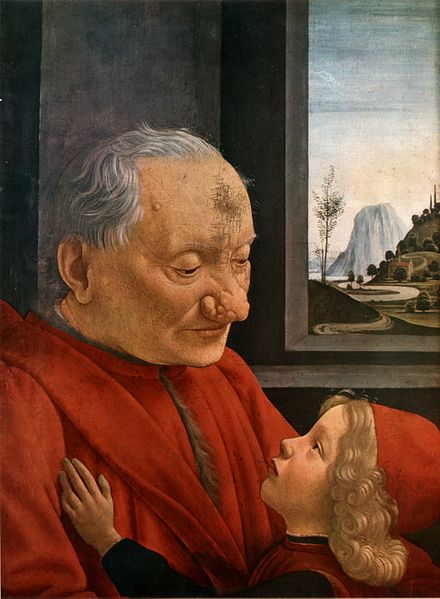
I’m still digesting Iain McGilchrist’s The Master and His Emissary, a book I heartily recommend if you enjoy some for the common themes of my blog. And thought I’d try a little analysis of this picture by Renaissance artist
Domenico Ghirlandaio, An Old Man and His Grandson, by way of exploring some of McGilchrist’s themes for myself.
I notice three things.

First, the sense of perspective through the window, not only in space, conveyed by the mountain, but also in time, conveyed by the winding road. For McGilchrist, this joint sensibility is characteristic of the full flourishing particularly of the right hemisphere in the art of the period. He describes a kind of movement, right to left to right. The right hemisphere first, as it were, picking up the whole of time and expansiveness of place the image shows; the left hemisphere then analysing the features of the image; and then handing back those specifics to the right in order to produce the synthesis that the picture offers: the powerful sense of two real individuals standing in relation to the world and in ‘lived time’.
Both hemispheres are required for this – the right’s capacity to see the whole, the left’s to discern the specifics. Bring the two aspects together, and the picture pulls at your imagination to see two human beings standing at a particular moment in relation to the broader context of cultural history. That’s the genius of Renaissance art’s perspective, in space and time.

A second feature that also incorporates this three-way dynamic is the sense of empathy the picture produces, which is one both of identification with the man and his grandson, but also a sense of distance from them. We view them knowing we’re not them, but we view them sympathetically. The distance between us and them is appropriate to allow them to be themselves, and to allow us to be with them too.
You can see the role the right hemisphere plays in this by the fact that the grandson rests against the old man’s left arm – thereby ensuring that the right hemisphere dominates in the act of seeing, the right being the side capable of emotional engagement. Hence, babies tend to be held in left arms too. The old man’s right arm (left hemisphere) serves to steady the son, a more precise act. But again, both are necessary for the two to meet in the way they do. Togetherness and distance.
The mood with which they meet is notable too, it being one of melancholy. Melancholy is not just sadness, rather it’s the feeling that arises from being wise about a situation. So the two seem conscious of their mortality, the old man looking on the new son, the new son wanting to be with the old man through his life, implicitly knowing he can’t. For McGilchrist, melancholy is characteristic of right hemisphere dominance because it is conscious of the mystery of beginnings and endings, of not being in control of sources and causes.
Conversely, positive thinking, or a certain kind of depression, might be moods precipitated by left hemisphere dominance. These two opposite feelings arise because the left hemisphere controls its world, but it controls only that world it carries within it, as a representation – an inner world that is therefore separated from the real world. Whilst the illusion of control remains in tact, positive thinking is possible. When the illusion of control goes, depression breaks out, as the left hemisphere on its own has little capacity to cope with the real world – the wisdom that only a dialectic with the right hemisphere can bring.

A third feature is the way the picture conveys the generations. These are not just two of a species related by their shared genes, a reading that requires first the categorisation of each into their biological part (elder male, younger male) and then a generalisation (the generations pass their genes on.) Rather the picture is of two distinct individuals whom we see in living relationship, together forming a family whole – though not losing their individuality in the process.
McGilchrist’s contention is that we live in an age which is losing sight of these kind of balances, this right-left-right capacity. Instead the left is dominating, so we document our world not live in it; become confused about the self because of an inability to achieve appropriate distance; and prefer generalisations rather than wholes, provoking crises of meaning.